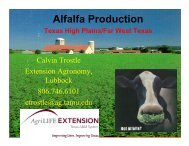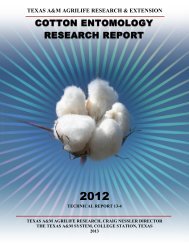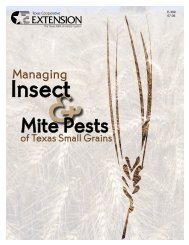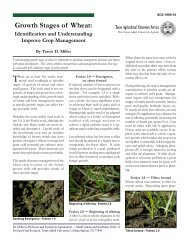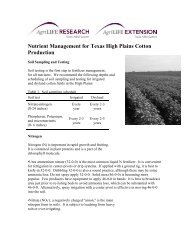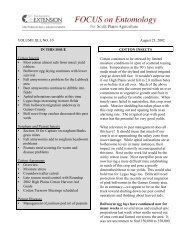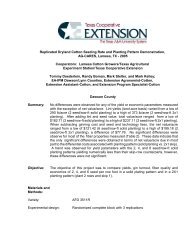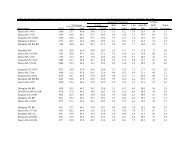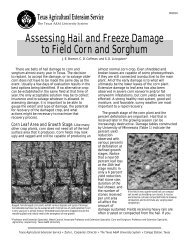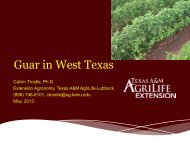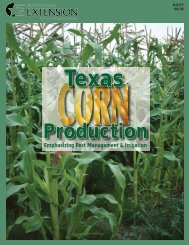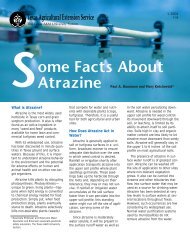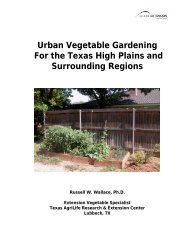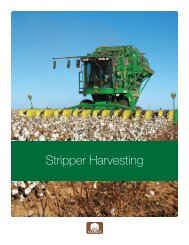Systems Agronomic and Economic Evaluation of Cotton Varieties in ...
Systems Agronomic and Economic Evaluation of Cotton Varieties in ...
Systems Agronomic and Economic Evaluation of Cotton Varieties in ...
Create successful ePaper yourself
Turn your PDF publications into a flip-book with our unique Google optimized e-Paper software.
Effects <strong>of</strong> Variable In-Season Irrigation Capacity on <strong>Cotton</strong>Project 11-811 TXJames P. Bordovsky, Texas A&M AgriLife Research,Lubbock/Halfway<strong>Cotton</strong> Incorporated Project Manager: Dr. Ed M. BarnesWith<strong>in</strong> the Ogallala Aquifer region, the available irrigation capacity on a given field canchange with<strong>in</strong> a grow<strong>in</strong>g season. Typically this is due to decl<strong>in</strong><strong>in</strong>g water tables. More recently, it isdue to growers divert<strong>in</strong>g irrigation from one crop (cotton) to other crops (corn) which may have highervalue, or are at a more critical growth stage than cotton, particularly <strong>in</strong> a year <strong>of</strong> low ra<strong>in</strong>fall.Furthermore, underground water conservation districts <strong>in</strong> the Texas High Pla<strong>in</strong>s will beg<strong>in</strong> enforc<strong>in</strong>gpump<strong>in</strong>g restrictions which could cause abrupt changes <strong>in</strong> irrigation rates as limits are reached.Preplanned tim<strong>in</strong>g <strong>of</strong> irrigations with available water allowances complicated by erratic ra<strong>in</strong>fall willbecome more critical.The objectives <strong>of</strong> this project were to:1. Determ<strong>in</strong>e cotton l<strong>in</strong>t yield, fiber quality, <strong>and</strong> water use efficiency as a function <strong>of</strong>comb<strong>in</strong>ations <strong>of</strong> irrigation capacities dur<strong>in</strong>g three cotton growth periods; <strong>and</strong> to2. Develop strategies to improve water management <strong>and</strong> water value <strong>in</strong> a semi-arid environment wherenew policies restrict irrigation volume <strong>and</strong> irrigation capacities are limited.The treatment factors <strong>in</strong>cluded <strong>in</strong>-season irrigation capacity (maximums <strong>of</strong> 0 <strong>in</strong>/d, 0.125 <strong>in</strong>/d,<strong>and</strong> 0.25 <strong>in</strong>/d) <strong>and</strong> irrigation application with<strong>in</strong> a specific growth period. Periods were determ<strong>in</strong>ed byheat unit (hu) accumulation <strong>and</strong> were generally designated as early vegetative/juvenile (< 950 hu),reproductive (950-1350 hu) <strong>and</strong> maturation period (>1350 hu). Comb<strong>in</strong>ations <strong>of</strong> these factor levelsresulted <strong>in</strong> 27 irrigation regimes or treatments. A 4-span LEPA pivot was used to irrigate 9.5 acres<strong>of</strong> this field experiment. The pivot was modified so that each 8-row section (40-<strong>in</strong> circular rows)along the lateral length could automatically provide different irrigation amounts depend<strong>in</strong>g on thetreatments be<strong>in</strong>g irrigated <strong>and</strong> pivot position. Groups <strong>of</strong> four valves (irrigat<strong>in</strong>g an 8-row plot) wereactuated us<strong>in</strong>g signals from a controller (Farmscan 7000, Dothan, Alabama) with specific timesequences for each irrigation treatment <strong>and</strong> distance from the pivot po<strong>in</strong>t. Inputs to the controllerwere pivot location (via GPS signal) <strong>and</strong> irrigation quantity (via application map) at each 8-row x 16-degree section for each irrigation sequence.Test results to date were obta<strong>in</strong>ed from years represent<strong>in</strong>g record break<strong>in</strong>g extremes - highra<strong>in</strong>fall <strong>in</strong> 2010 <strong>and</strong> low <strong>and</strong> <strong>in</strong>effective ra<strong>in</strong>fall <strong>in</strong> 2011 <strong>and</strong> 2012. In all years, cotton yield <strong>and</strong> waterproductivity data <strong>in</strong>dicated that build<strong>in</strong>g soil water <strong>in</strong> the pr<strong>of</strong>ile, or irrigat<strong>in</strong>g <strong>in</strong> excess <strong>of</strong> theevapotranspiration rate <strong>of</strong> the cotton plants, reduced irrigation water value compared to apply<strong>in</strong>girrigation later <strong>in</strong> the grow<strong>in</strong>g season. This was attributed to water loss from excessive evaporation(high w<strong>in</strong>d, low humidity) that <strong>of</strong>ten occurs <strong>in</strong> May <strong>and</strong> June on the Texas High Pla<strong>in</strong>s. Irrigationwater value dur<strong>in</strong>g reproductive <strong>and</strong> maturation periods resulted <strong>in</strong> water use efficiencies <strong>in</strong> excess <strong>of</strong>100 lb/ac-<strong>in</strong>ch <strong>of</strong> irrigation applied. Additional field tests can provide the foundation for <strong>in</strong>-seasonirrigation recommendations that will optimize l<strong>in</strong>t yield (<strong>and</strong> water value) based on irrigation pump<strong>in</strong>g<strong>and</strong> volume restrictions.From <strong>Cotton</strong> Incorporated Annual Report, Project TX 11-811 for 2012Texas A&M AgriLIFE ResearchJames P. Bordovsky, P.E., 806 889 3315, j -bordovsky@tamu.edu135



